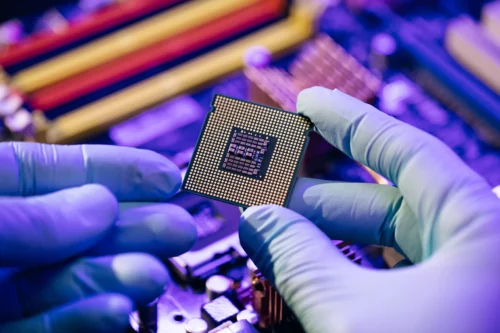

The Criticality of Semiconductors in Global Markets
Semiconductors are the perfect brains for electronic devices. With their conductivity which depends on the environment, semiconductor chips are considered a critical infrastructure in modern society, quietly powering the technological revolution that has transformed nearly every aspect of our lives. They have become indispensable in a multitude of applications, ranging from smartphones and laptops to medical devices and systems of transportation. Moreover, semiconductors also play a vital role in national defense and military, centering them in the multitudes of political tensions over the past decade.
Over time, the miniaturization of transistors and the increasing complexity of integrated circuits have led to a phenomenon known as Moore’s Law, which predicts that the number of transistors on a chip and thus the processing speed of computers will double approximately every two years. The relentless progress made with respect to research and development of chip manufacturing has made it possible to develop ever-more powerful and energy-efficient devices, driving innovation in fields such as artificial intelligence, data analytics, and scientific research, allowing society to address complex challenges that were once unimaginable. This progress also interlinks with their indelible impact on global policy and tech business decision-making.

Source: FairObserver
Sovereign chip manufacturing capability has remained a national security imperative for decades. Dating back to the mid 1980s, the Reagan administration laid a strong emphasis on a global leadership in chips to counter the Soviet Union through satellites, stealth aircraft and cruise missiles. 40 years later, in modern-day warfare, semiconductors continue to play a crucial role in powering a range of military equipment including drones, radios, missiles and armoured vehicles, as well as in aerospace sectors such as communication satellites and the global positioning system (GPS).
Semiconductors, International Tensions and Policy
However, there are shortfalls regarding how truly intrinsic semiconductors are to nations. The global chip shortage induced supply chain disruptions and geopolitical tensions. Further, the actions of an increasingly assertive China led to the world becoming increasingly concerned about the overreliance of the Taiwan Semiconductor Manufacturing Company (TSMC) in the production of chips. This stems from TSMC manufacturing around 90% of the world’s most advanced chips and occupying 56.7% of the market share for semiconductor foundries, (foundries are facilities that manufacture chips).
In response, the United States has taken an aggressive but bipartisan approach to remediate such concerns through the passage of the CHIPS and Science Act of 2022, unlocking $52.7 billion of funding for chip research, development, and manufacturing. Chip manufacturers are already rushing to capitalise on federal subsidies and state funding offered by state legislatures, most notably, the Texas CHIPS Act, designed to complement the federal legislation which will inject an additional $1.4 billion into Texan microchip technology research. Companies from Texas Instruments and Samsung Electronics are already investing $30 billion and $17 billion respectively to establish fabrication plants in Texas. Furthermore, TSMC’s $12 billion chip plant in Arizona is also considered a significant investment given their role as industry leaders. Thus, the United States is on a promising path to reshore and expand chip manufacturing and as a result, creating 319,000 jobs in the semiconductor industry and a total jobs impact of 2.13 million by 2027 in the process. As at 2020, the chip industry has contributed $246.4 billion in GDP and this is expected to grow exponentially as manufacturing plants become operational.

Source: CNBC
Additionally, consequent to national security concerns, the United States has placed sanctions on chip technology exports, aimed to thwart China’s ability to develop advanced artificial intelligence with the primary concern that it may be deployed for hostile intelligence activities and advanced weapons systems. Analysts have suggested this is likely to have a profound impact on the Chinese industry given they are heavily reliant on foreign technologies to support their chip manufacturing capabilities. Moreover, the performance of US defense systems is dependent on semiconductors, in the absence of sovereign microchip production the US and its allies will be left vulnerable.
Over and above the national security concerns involved, reshoring chip manufacturing ensures supply chain resilience that is able to withstand any disruptions, such as COVID-19’s industry impacts which spread shockwaves throughout the global economy, especially since this was also a period in which demand for electronics increased significantly. The resulting chip shortage caused widespread disruptions in other industries such as automobiles, computers and household appliances which significantly drove up prices. Together, these factors have influenced governments around the world, particularly the USA, to prioritize and implement a comprehensive strategy to obtain technological leadership in the semiconductor industry.

Source: ABC
Meanwhile, on the other side of the world, China seems to have made a leap forward in its technological war with the US. In 2022, when the CHIPS and Science Act was first introduced, a ban on the sale of advanced semiconductor and chip-manufacturing technologies to China was instituted. Consequently, countries like Japan and the Netherlands agreed to comply with their provisions, with the Netherlands-based ASML Holding company to stop the sale of its most advanced extreme ultraviolet lithography machines to China – a key component of the manufacturing process. However, sooner than expected, China seems to have caught up on its own terms, with the Shanghai-based Micro Electronics Equipment Group declaring to have gained domestic access to advanced chips, developing lithography machines capable of producing transistors on par with ASML, which are needed for advanced smartphones, computers and weapons at the technological forefront. Only time will reveal how much progress has been made. At the moment, it seems that research in China has successfully managed to decrease its chips size from 7 nm to 5 nm, marking a significant progress in China’s semiconductor capabilities.
The Future of the Semiconductor Industry
Considered just as valuable as oil reserves, the semiconductor industry has emerged intrinsically significance in response to increased demand by the technological industry. Hence, semiconductor markets in new countries arise, mediated by geo-political tensions and alliances.
As aforementioned, Taiwan is currently the leading foundry hub of semiconductor manufacturing, and with the looming threat of war and increasing tensions between the US and China, India has positioned itself as an emerging hub for semiconductor manufacturing, aiming to play a prominent role on the global stage. This strategic move also reflects their escalating tensions with China, as the newly agreed India-US Memorandum of Understanding Pact could have a profound impact on China’s semiconductor supply chain interests. Furthermore, the Indian government has invested heavily into the development of their technology and engineering industries, which translates into their semiconductor industry with a new $10 billion subsidization deal introduced, attracting foreign direct investment possibilities from the US particularly. This offer has been snapped up by major semiconductor R&D companies such as AMD and Micron, which are rapidly setting up semiconductor facilities in Bangalore, promoting industrial and job growth in India. Deloitte has projected that India’s current market share is projected to double by 2026 to 10%, indicating exponential growth. In conjunction with their competitively large and skilled labor market, India offers a promising addition to the global microchip value chain.
Furthermore, the semiconductor industry, particularly with regard to manufacturing and supply chain processes, is being revolutionized by the introduction of AI. With the AI industry having a projected growth of $390.9 Billion USD by 2025, it is imperative for semiconductor manufacturers to capitalize on this. This is vital to ensure competitiveness within the saturated and difficult market, particularly with tech giants like Google and Adobe diving into generative artificial intelligence technology development and creating a necessity for AI-focused semiconductors. Additionally, interesting future applications of AI emerge in the manufacturing sector targeting waste reductions in the R&D process as AI can be leveraged to streamline chip production processing time. By applying AI to optimize efficiency and increase output, substantial savings in time and cost will emerge.
The importance of implementing AI is demonstrated by the success of emerging AI semiconductor companies such as ARM, who achieved 2023’s highest I.P.O at a record $4.87 Billion USD. Large companies such as NVIDIA have also taken upon a mission to implement AI/machine learning, reflecting a dynamic shift in the comprehension of AI’s cruciality in the future of semiconductors. South Korea, another emerging foundry hub, has placed AI at the forefront of their mission, aiming to fill the niche and capitalize off of the new market. McKinsey forecasts that AI has a possibility of generating over $85 billion USD for the semiconductor industry in the long term.
Whilst semiconductors are used in tactical, national defense and military applications, on a broader scale, semiconductors witness integrations beyond the industrial sector, including direct-to-consumer product markets. This ranges from 5G, smartphones, healthcare equipment, to self-driving cars. The sheer breadth of roles in which semiconductors can be applied highlight the importance of semiconductors as both vessels for strategically mitigating geopolitical tensions but also as a driving force propelling economic growth. Especially with the escalating tensions between US and China and other countries’ involvement, the future of the semiconductor industry remains temperamental. Despite this, the adoption of AI opens up a compelling new frontier for the semiconductor industry to explore, offering up a burgeoning economic and technological market laden with vast potential.
The CAINZ Digest is published by CAINZ, a student society affiliated with the Faculty of Business at the University of Melbourne. Opinions published are not necessarily those of the publishers, printers or editors. CAINZ and the University of Melbourne do not accept any responsibility for the accuracy of information contained in the publication.